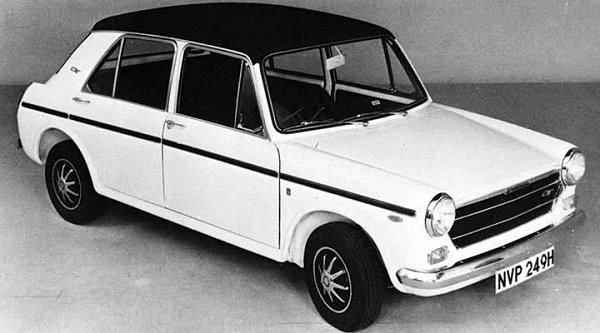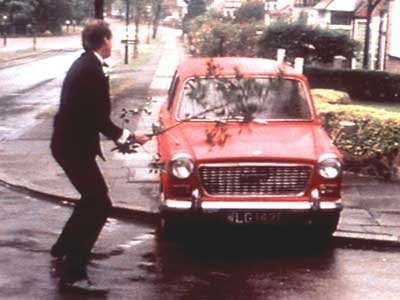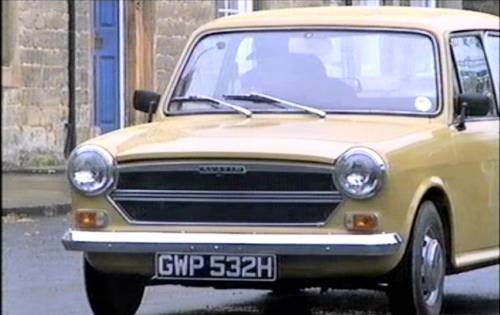BMC ADO16 1100 1275 1300
Austin, Morris,Vanden Plas, Princess, MG, Wolseley, Riley, Kestrel, Innocenti IM3
| 1962 to 1974 | |
|---|---|
 |
|
| Overview | |
| Manufacturer | BMC British Leyland |
| Production | 1962–1974 |
| Designer | Sir Alec Issigonis |
| Body and chassis | |
| Class | Compact car |
| Body style | 4-door saloon 2-door saloon 2-door estate |
| Layout | Front engine, front-wheel drive |
| Dimensions | |
| Wheelbase | 93.5 in (2,375 mm) |
| Length | 146.65 in (3,725 mm) (saloon & estate) |
| Width | 60.38 in (1,534 mm) |
| Height | 53 in (1,346 mm) |
| Kerb weight | 1,834 lb (832 kg) approx |
Models included:
- Austin 1100 and 1300
- Austin America, Glider and Victoria
- Innocenti IM3
- MG 1100 and 1300
- Morris 1100 and 1300
- Riley 1300 and Kestrel
- Vanden Plas Princess 1100 / 1275 / 1300
- Wolseley 1100, 1275 and 1300
Although most of the cars were manufactured in England, they were also built in Spain by Authi, in Italy by Innocenti and at the company's own plant in Belgium. It was the basis for locally adapted similar cars manufactured in Australia and South Africa. Various versions including Austin, Morris, MG, Wolseley and Riley were assembled in New Zealand from CKD kits from 1963 until the final Austin/Morris versions were replaced by the Allegro in 1975.
The vehicle was launched as the Morris 1100 on 15 August 1962. The range was expanded to include several rebadged versions, including the twin-carburettor MG 1100, the Vanden Plas Princess (from October 1962), the Austin 1100 (August 1963), and finally the Wolseley 1100 (1965) and Riley Kestrel (1965). The Morris badged 1100/1300 gave up its showroom space to the Morris Marina in 1971, but Austin and Vanden Plas versions remained in production in the UK till June 1974.
The estate version followed in 1966, called Countryman in the Austin version and Traveller in the Morris one, continuing the established naming scheme. The Austin 1100 Countryman appeared in the legendary "Gourmet Night" episode of Fawlty Towers, in which short tempered owner of Fawlty Towers Basil Fawlty (John Cleese) gave it a "damn good thrashing". This episode was first shown in October 1975.
In 1964 the 1100 was Wheels magazine's Car of the Year.
Design and development
The ADO16 (Amalgamated Drawing Office project number 16) was designed by Alec Issigonis. Following his success with the Mini, Issigonis set out to design a larger and more sophisticated car which incorporated more advanced features and innovations. In common with the Mini, the ADO16 was designed around the BMC A-Series engine, mounted transversely and driving the front wheels. As well as single piston swinging caliper disc brakes at the front, which were not common on mass-produced cars in the early 1960s, the ADO16 featured a Hydrolastic interconnected fluid suspension system designed by Alex Moulton. The mechanically interconnected Citroen 2CV suspension was assessed in the mid-1950s by Alec Issigonis and Alex Moulton (according to an interview by Moulton with CAR magazine in the late 1990s),and was an inspiration in the design of the Hydrolastic suspension system for the Mini and Austin 1100, to try to keep the benefits of the 2CV system (ride comfort, body levelling, keeping the roadwheel under good control and the tyre in contact with the road), but with added roll stiffness that the 2CV lacked. Pininfarina, the Italian styling studio which had worked with BMC before on the Austin A40 Farina, was commissioned to style the car. ADO16 had comparable interior space to the larger Ford Cortina.
BMC engineer Charles Griffin took over development work from Issigonis at the end of the 1950s while Issignois completed work on the Mini. Griffin ensured the 1100 had high levels of refinement, comfort and presentation. Griffin would later have overall responsibility for the Princess, Metro, Maestro and Montego ranges.
The ADO16 range sold 2.1 million units between 1962 and 1974.
Mark I (1962–1967)
The original Mark I models were distinctive for their use of a Hydrolastic suspension. Marketing material highlighted the spacious cabin when compared to competitor models which in the UK by 1964 included the more conservatively configured Ford Anglia, Vauxhall Viva HA and BMC's own still popular Morris Minor.
The Mark I Austin / Morris 1100 was available, initially, only as a four-door saloon. In March 1966 a three-door station wagon became available, badged as the Morris 1100 Traveller or the Austin 1100 Countryman. Domestic market customers looking for a two-door saloon would have to await the arrival in 1967 of the Mark II version, although the two-door 1100 saloon had by now been introduced to certain oversea markets, including the USA where a 2-door MG 1100 was offered.
An Automotive Products (AP) four-speed automatic transmission was added as an option in November 1965. In order to avoid the serious levels of power loss then typical in small-engined cars with automatic transmission the manufacturers incorporated a new carburettor and a higher compression ratio in the new 1965 automatic transmission cars: indeed a press report of the time found very little power loss in the automatic 1100, though the same report expressed the suspicion that this might in part reflect the unusually high level of power loss resulting from the way in which the installation of the transversely mounted "normal" manual gear box had been engineered.
Engine
- 1962–1974: 1098 cc A-Series I4
Mark II (1967–1971)
At the end of May 1967, BMC announced the fitting of a larger 1275 cc engine to the MG, Riley Kestrel, Vanden Plas and Wolseley variants. The new car combined the 1275 cc engine block already familiar to drivers of newer Mini Cooper S and Austin-Healey Sprite models with the 1100 transmission, its gear ratios remaining unchanged for the larger engine, but the final-drive being significantly more highly geared.
The Mark II versions of the Austin and Morris models were announced, with the larger engine making it into these two makes' UK market ranges in October 1967 (as the Austin 1300 and Morris 1300). An 1100 version of the Mark II continued alongside the larger-engined models.
Unusually for cars at this end of the market, domestic market waiting lists of several months accumulated for the 1300-engined cars during the closing months of 1967 and well into 1968.The manufacturers explained that following the devaluation of the British Pound in the Fall / Autumn of 1967 they were working flat out to satisfy export market demand, but impatient British would-be customers could be reassured that export sales of the 1300s were "going very well".MG, Wolseley, Riley and Vanden Plas variants with the 1300 engines were already available on the home market in very limited quantities, and Austin and Morris versions would begin to be "available here in small quantities in March 1968".
On the outside, a slightly wider front grille, extending a little beneath the headlights, and with a fussier detailing, differentiated Austin / Morris Mark IIs from their Mark I predecessors, along with a slightly smoother tail light fitting which also found its way onto the FX4 London taxi of the time. Austin and Morris grilles were again differentiated, the Austin having wavy bars and the Morris straight ones. The 1100 had been introduced with synchromesh on the top three ratios: all synchromesh manual gearboxes were introduced with the 1275 cc models at the end of 1967 and found their way into 1098 cc cars a few months later.
Mark II versions of the MG, Riley, Vanden Plas and Wolseley were introduced in October 1968, at which time Riley abandoned the Kestrel name. The Riley 1300 Mark II was cancelled in July 1969, and was the last Riley.
At the London Motor Show in October 1969 the manufacturers introduced the Austin / Morris 1300 GT, featuring the same 1275 cc twin carburetter engine as that installed in the MG 1300, but with a black full width grill, a black vinyl roof and a thick black metal strip along the side. This was BMC's answer to the Ford Escort GT and its Vauxhall counterpart.Ride height on the Austin / Morris 1300 GT was fractionally lowered through the reduction of the Hydrolastic fluid pressure from 225 to 205 psi.
Engine
- 1967–1971: 1098 cc A-Series I4
- 1967–1971: 1275 cc A-Series I4
During 1970, despite being fundamentally little changed since the introduction of the Morris 1100 in 1962, the Austin/Morris 1100/1300 retained its position as Britain's top selling car, with 132,965 vehicles registered as against 123,025 for the Ford Cortina, in that year entering its third incarnation. By the time the two millionth ADO16 was produced, at the end of June 1971, the Morris badged version of the car had been withdrawn in order to create space in the range and in the showrooms for the Morris Marina. 1970 turned out to be the 1100/1300's last year at the top of the UK charts.
Mark III (1971–1974)
The Mark III models were introduced in September 1971. At the launch of the Morris 1100 in 1962 the manufacturer stated that they intended for the ADO16 models to remain in production for at least ten years, which despite BMC's vicissitudes through the 1960s turned out to be reasonably prescient. The range was gradually reduced, with the MG 1300 dropped in 1971 and the Wolseley 1300 in 1973. The final British ADO16, a Vanden Plas Princess 1300, left the factory on 19 June 1974. The ADO16 was replaced by the Austin Allegro and its Vanden Plas 1500 counterpart. By this time, its original rival, the Ford Cortina, had already grown larger, putting ADO16 into the small, rather than medium-sized class.
ADO16 production overlapped for more than a year with the Allegro.
Engine
- 1971–1974: 1098 cc A-Series I4
- 1971–1974: 1275 cc A-Series I4
ADO16 overseas
The car was sold with various names in different markets.
In Spain it was sold as Morris, Austin and MG, starting production in the Pamplona Authi (Automóviles de Turismo Hispano Ingleses) factory in 1966, and evolving by 1972 into the Austin Victoria.
In Denmark the ADO16 bore the Morris Marina name. The MG models were sold as the MG Sports Sedan there, as it was in North America from 1962, and was available with a two-door bodyshell that would not be available in the UK until 1968. The Vanden Plas Princess was briefly the MG Princess 1100 in North America, while that market also saw an unusual two-door Austin 1100 (with a hybrid of Mark I and Mark II components). In the Netherlands the Austin version was sold as the Austin Glider.
The Austin America was sold in the US, Canada and Switzerland between 1968 and 1972. This two-door version of the car featured a 60 bhp (45 kW) 1275 cc engine. Various modifications were made to suit the US market including an "anti-pollution air injection system", a split circuit braking system, rocker switches in place of some of the dashboard mounted knobs, a "hazard warning system" and flush door locks.
The ADO16 also formed the basis of the Australian Morris 1500 sedan, Morris 1300 sedan and Morris Nomad five-door, the Italian Innocenti Morris IM3 and Austin I4 and I5, the more powerful South African Austin, Morris and Wolseley 11/55 and Austin Apache and the Spanish Austin Victoria and the Austin de Luxe of 1974 to 1977, which had a 998 cc engine.
The Austin Apache was produced until 1977, the last of the ADO16 line.
1967 Austin 1100 Countryman MkI ADO16 in Fawlty Towers, TV Series

Austin 1300 in Heartbeat tv program

Technical
-
BMC ADO16 Technical details and specifications (1962-1974)
ENGINE: 1100
front, 4 stroke, transverse
cylinders: 4, vertical, in line
bore and stroke: 2.54 x 3.29 in, 64.6 x 83.7 mm
engine capacity: 67 cu in, 1,098 cu cm
compression ratio: 8.9
cylinder block: cast iron
cylinder head: cast iron
crankshaft bearings: 3
valves: 2 per cylinder, overhead, in line, push-rods and rockers
camshafts: 1, side
lubrication: eccentric pump, full flow filter
lubricating system capacity: 8.80 imp pt, 10.57 US pt, 5 1
carburation: 2 SU type HS 2 semi-downdraught carburettors
fuel feed: electric pump
cooling system: waterENGINE: 1300
4 stroke, transverse; cylinders: 4, vertical, in line
bore and stroke: 2.78 x 3.20 in, 70.6 x 81.3 mm
engine capacity: 77.80 cu in, 1,275 cu cm
compression ratio: 8.8 Mark II 9.7
cylinder block: cast iron
cylinder head: cast iron
crankshaft bearings: 3
valves: 2 per cylinder, overhead, in line, push-rods and rockers
camshafts: 1, side
lubrication: gear or vane-type pump, full flow filter
carburation: 1 SU type HS 2 semi-downdraught carburettor, Mark II 2 SU type HS.
fuel feed: electric pump
cooling system: waterTRANSMISSION
driving wheels: front
clutch: single dry plate, hydraulically controlled
gearbox: mechanical; gears: 4 + reverse
synchromesh gears: 2nd, 4th
gearbox ratios: 1st 3.627, 2nd 2.172, 3rd 1.412, 4th 1, rev 3.627
final drive: helical spur gears; axle ratio: 4.133.CHASSIS
type integral with front and rear auxiliary frames
front suspension: independent, wishbones, hydrolastic (liquid) rubber cone springs, hydraulic connecting pipes to rear wheels
rear suspension: independent, swinging longitudinal trailing arms, hydrolastic (liquid) rubber cone springs, hydraulic connecting pipes to front wheels, combined with transverse torsion bars, anti-roll bar.STEERING
rack-and-pinion
turns of steering wheel lock to lock: 3.
turning circle (between walls): 34 ft, 10.4 mBRAKES
front disc (diameter 8 in, 203 mm)
rear drum; area rubbed by linings: total 196.20 sq in, 1,265.49 sq cm.ELECTRICAL EQUIPMENT
voltage: 12 V
battery: 43 Ah
generator type: dynamo, 264 W
ignition distributor: Lucas Automatic advance and retard With centrifugal and vacuum control.
rear-mounted S.C. electric fuel pump
double-dipping sealed-beam headlamps
parking lights
twin stoptail lamps; rear reflectors
number-plate lamps
flashing direction indicators with repeater flashers on wings
single lever on steering-column combines horn, headlamp flasher, dip switch, and self-cancelling direction flashers
instrument and parcel shelf lamps
dual-arm windscreen Wipers
twin electric horns
interior roof light With courtesy switch
warning lights for ignition, headlight main beam, oil pressure, , and direction indicators.DIMENSIONS AND WEIGHT
wheel base: 93.50 in, 2,375 mm
front track: 51.50 in, 1,308 mm
rear track: 50.87 in, 1,292 mm
overall length: 146.75 in, 3,727 mm
overall width: 60.37 in, 1,533 mm
overall height: 53 in, 1,346 mm
ground clearance: 6 in, 152 mm
dry weight: 1,852 1b, 840 kg© Motor car History
Service
-
BMC ADO16 maintenance and Service Guide (1962-1974)
Greasing: every 3,000 miles, 4,800 km, 4 points
Normal tyre pressure: front 28 psi, 2 atm, rear 24 psi, 1.7 atm.
Tyres: 5.50 x 12 tubeless
Wheels: ventilated disc-type 4J x 12 in. wheels with four-studs
Fuel tank capacity: 8.5 imp gal, 10.3 US gal, 39 1.
Carrying capacity: 882 1b, 400 kg
Spare Wheel: housed in luggage compartment1100
fuel: 98-100 oct petrol
engine oil, gearbox and final drive oil: 6.70 imp pt, 8.03 US pt, 3.8 1, SAE 1OW-30, change every 6,000 miles, 9,700 km
air filter: Paper element air cleaner With silencer.
Fuel Filters contained in fuel tank and fuel pump. Tank is fitted under luggage boot
cooling system capacity: 6.80 imp pt, 8.24 US pt, 3.9 1
tappet clearances: inlet 0.012 in, 0.30 mm, exhaust 0.012 in, 0.30 mm
valve timing: inlet opens 5° before tdc and closes 45° after bdc, exhaust opens 51° before bdc and closes 21° after tdc1300
fuel: 98-100 oct petrol
engine sump, gearbox and final drive oil: 7.50 imp pt, 9.09 US pt, 4.3 1, SAE 10W-30, change every 6,000 miles, 9,700 km
Total lubricating system capacity: 9 imp pt, 10.78 US pt
cooling system capacity: 6.80 imp pt, 8.24 US pt
tappet clearances: inlet 0.012 in, 0.30 mm, exhaust 0.012 in, 0.30 mm
valve timing: inlet opens 5° before tdc and closes 45° after bdc, exhaust opens 51° before bdc and closes 21° after tdc© Motor car History
